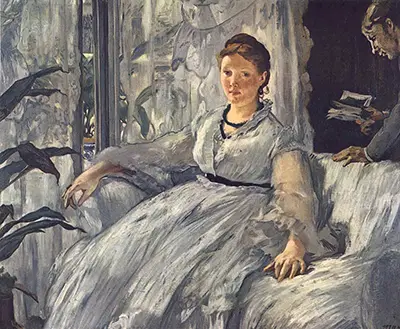The Reading by Edouard Manet manifests the technique of realism intertwined with impressionism.
The piece is an oil on canvas painting, created by the artist between 1865-1873. The first exhibition of the painting took place in 1880, as Manet showcased his work through a personal exhibition within his studio. The painting is currently held at the Musee d’Orsay in Paris, France. The muse behind the painting is Edouard Manet's wife, Suzanne Manet, on a couch with their son Leon standing in the background reading a book. Manet had used his son Leon in a few of his prior paintings, including The Lunch, The Boy Carrying The Sword and The Bubbles of Soap. Manet’s wife Suzanne was also a reoccurring muse for the artist.
During the time period, Manet had shifted his style into the warmer tones of impressionist painting, which was popular during the era. Manet had transformed his work into more intimate pieces, showcasing a significant amount of detail. The Reading illustrates this shift as Manet manifests a woman sitting on a couch starring at the viewer. The muse is dresses in a sheer flowy white dress, layered in shades of grey. The dress is painted in an immense amount of detail, highlighting and contouring every fold in the fabric. The couch on which the model sits upon continues in a similar fabric, white grey chiffon. The woman carries a few black details, which includes a thin black belt, and a black-bedded necklace. The curtains in the background seem to continue this light grey fabric, however seems to be based on more of a lace material.
This warm tone accentuates the painting, creating a calm allure as the woman stares at the viewer. The woman holds an incredibly monotone expression on her face, neither happy nor sad. The individual in the background of the painting seems to look like a man, however is the Manet's son. He is engulfed by the book he is reading, however holds the pose as he places a hand on the couch. The plant within the painting adds the element of life to the posed bodies within the piece. The dark background wall generates a strategic contrast between the curtains, illustrating the different shades of grey fabric found within the piece. The face of Manet’s wife is drawn to conclude as the focal point of the piece as her skin is illuminated in warm colours compared to the rest of the piece. Her light brown hair gently adds a welcoming essence to her, as he small eyes beam into the viewers.




